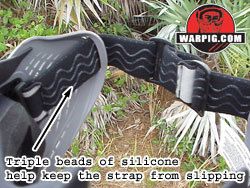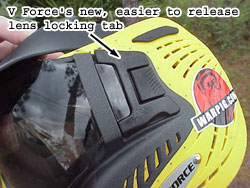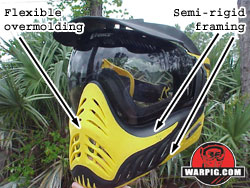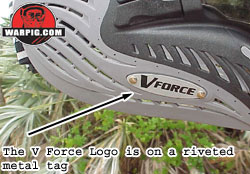
What
do you think?
Add
your comments in WARPIG's TECH TALK FORUMS.
|

V Force Profiler
By Bill Mills - April
2004
 In
the late 1990s, Leader entered the paintball goggle market by producing
goggles sold under the Brass Eagle brand name. They changed thoughts
about goggle design with the Eagle Vision goggle and its radical “bubble”
lens. When Brass Eagle bought JT USA, they dropped the Leader line.
Leader re-invented their paintball image, creating the V Force brand name,
re-labeling a goggle that never drew much attention with the BE nametag
into the V Force Shield, and releasing the Morph, which was essentially
the same goggle with a flexible bottom half mask. In
the late 1990s, Leader entered the paintball goggle market by producing
goggles sold under the Brass Eagle brand name. They changed thoughts
about goggle design with the Eagle Vision goggle and its radical “bubble”
lens. When Brass Eagle bought JT USA, they dropped the Leader line.
Leader re-invented their paintball image, creating the V Force brand name,
re-labeling a goggle that never drew much attention with the BE nametag
into the V Force Shield, and releasing the Morph, which was essentially
the same goggle with a flexible bottom half mask.
V Force’s coming out party was at the
2000 World Cup. V Force was exclusively distributed by Diablo Direct,
and the Diablo crew kicked off the V Force name with a lens changing for
cash competition that highlighted just how fast the goggle system could
be serviced. Prior to Diablo Direct carrying the V Force line, Airtech
Innovations had been producing the Skull for Diablo Direct, a goggle with
a single unit frame/mask that was entirely molded out of flexible material.
The Skul quickly faded into the background of the Diablo Direct line, overshadowed
by the V Force systems.
 With
sponsorships of major teams putting their goggle in the spotlight, the
V Force brand caught on quick. Fast forward to three years later
and behind the scenes changes have happened, but the V Force line remained
in place with the Morph as its flagship. Diablo Direct had been merged
into National Paintball Supply and Airtech Innovations had acquired the
V Force line (and some of the V Force staff) as a result of Leader undergoing
a debt settlement corporate restructuring. While the Morph and Shield
were popular, Airtech knew it was time to release a new model. With
sponsorships of major teams putting their goggle in the spotlight, the
V Force brand caught on quick. Fast forward to three years later
and behind the scenes changes have happened, but the V Force line remained
in place with the Morph as its flagship. Diablo Direct had been merged
into National Paintball Supply and Airtech Innovations had acquired the
V Force line (and some of the V Force staff) as a result of Leader undergoing
a debt settlement corporate restructuring. While the Morph and Shield
were popular, Airtech knew it was time to release a new model.
 Paintball
mask designers have faced a tough challenge – they have to balance protection
of the face, temples and ears with the desire of professional tournament
paintball players who are marketing vehicles for their products wanting
something that is soft and unlikely to break a paintball. Most higher
end goggle systems address this by using a rigid goggle support structure,
and a hard upper-half mask, combined with a flexible lower portion.
The problem with this approach is that if the lower portion is too flexible,
it offers less protection, and can swing back impacting the mouth or chin
when hit by a paintball. Paintball
mask designers have faced a tough challenge – they have to balance protection
of the face, temples and ears with the desire of professional tournament
paintball players who are marketing vehicles for their products wanting
something that is soft and unlikely to break a paintball. Most higher
end goggle systems address this by using a rigid goggle support structure,
and a hard upper-half mask, combined with a flexible lower portion.
The problem with this approach is that if the lower portion is too flexible,
it offers less protection, and can swing back impacting the mouth or chin
when hit by a paintball.
 Richmond
Italia, one of the owners of Airtech walked into the office of V Force
development team leader Zbid Migos to explain the concept he wanted to
see in the company’s new mask. He cut out sections of a Shield mask,
and replaced them with portions of a more flexible Skul mask. With
that starting point Migos was off to work developing the Profiler.
According to Migos, he faced not just technical challenges designing the
Profiler, but also image challenges. “It has a distinctive grill,”
he says. “It has to look aggressive without looking monsterous,”
he told WARPIG.com, referring to his goal of reaching a design what would
appeal visually to a wide variety of players. Richmond
Italia, one of the owners of Airtech walked into the office of V Force
development team leader Zbid Migos to explain the concept he wanted to
see in the company’s new mask. He cut out sections of a Shield mask,
and replaced them with portions of a more flexible Skul mask. With
that starting point Migos was off to work developing the Profiler.
According to Migos, he faced not just technical challenges designing the
Profiler, but also image challenges. “It has a distinctive grill,”
he says. “It has to look aggressive without looking monsterous,”
he told WARPIG.com, referring to his goal of reaching a design what would
appeal visually to a wide variety of players.
 Prototype
Profiler goggles were seen on a number of V Force sponsored pro players
in the 2003 season, but the goggle system didn’t get its official unveiling
until the 2003 PSP World Cup. The goggle system utilizes the familiar
V Force lens and all of its optical characteristics, with a slightly different
retention clip, making removal for cleaning or replacement easier than
with the previous models. A flexible tab in the center of the retention
clip helps pop the clip out, so the lens can be unlocked from the goggle. Prototype
Profiler goggles were seen on a number of V Force sponsored pro players
in the 2003 season, but the goggle system didn’t get its official unveiling
until the 2003 PSP World Cup. The goggle system utilizes the familiar
V Force lens and all of its optical characteristics, with a slightly different
retention clip, making removal for cleaning or replacement easier than
with the previous models. A flexible tab in the center of the retention
clip helps pop the clip out, so the lens can be unlocked from the goggle.
 The
mask structure consists of a semi-rigid framework for the goggles that
also extends down, like a skeleton framework, to cover the chin area.
In the sides, and over most of the face is a flexible rubber like material
that is overmolded to the rigid framework below it. According to
Migos, this presented a few technical challenges, that required refinements
to the injection molding process. The
mask structure consists of a semi-rigid framework for the goggles that
also extends down, like a skeleton framework, to cover the chin area.
In the sides, and over most of the face is a flexible rubber like material
that is overmolded to the rigid framework below it. According to
Migos, this presented a few technical challenges, that required refinements
to the injection molding process.
 The
result is that the mask retains its shape and has the strength to keep
from flexing back to the chin when hit, but the center portion and sides
of the mask still have a degree of flexibility to promote bounces.
A variety of bold colors for the flexible portion of the mask have helped
make its appearance easy to recognize. Small metal tabs riveted on
the sides show the V Force brand name, but are often removed by tournament
players to increase the mask’s bounce factor. The
result is that the mask retains its shape and has the strength to keep
from flexing back to the chin when hit, but the center portion and sides
of the mask still have a degree of flexibility to promote bounces.
A variety of bold colors for the flexible portion of the mask have helped
make its appearance easy to recognize. Small metal tabs riveted on
the sides show the V Force brand name, but are often removed by tournament
players to increase the mask’s bounce factor.
 Included
with the goggle are two different visors. The short visor offers
protection to the forehead but does not protrude past the lens, while the
long visor gives the same protection, but also acts as a sun-shade to reduce
glare. Inside the mask, where the goggle area fits to the face is
V Force’s two layer foam – a thick layer attaches to the mask, and acts
as a backing, providing a longer service life for the softer foam that
fits up against the player’s face. Included
with the goggle are two different visors. The short visor offers
protection to the forehead but does not protrude past the lens, while the
long visor gives the same protection, but also acts as a sun-shade to reduce
glare. Inside the mask, where the goggle area fits to the face is
V Force’s two layer foam – a thick layer attaches to the mask, and acts
as a backing, providing a longer service life for the softer foam that
fits up against the player’s face.
 The
V Force Profiler has already gained wide acceptance, with the few units
available at World Cup running out fast, and full production levels shipping
shortly therafter. Migos commented that sales in the first three
months of 2004 had already exceeded Airtech's projections for the entire
year. He credits much of the success of the goggle to its distinctive
look that allows players to easily recognize it when making purchases. The
V Force Profiler has already gained wide acceptance, with the few units
available at World Cup running out fast, and full production levels shipping
shortly therafter. Migos commented that sales in the first three
months of 2004 had already exceeded Airtech's projections for the entire
year. He credits much of the success of the goggle to its distinctive
look that allows players to easily recognize it when making purchases.
|





